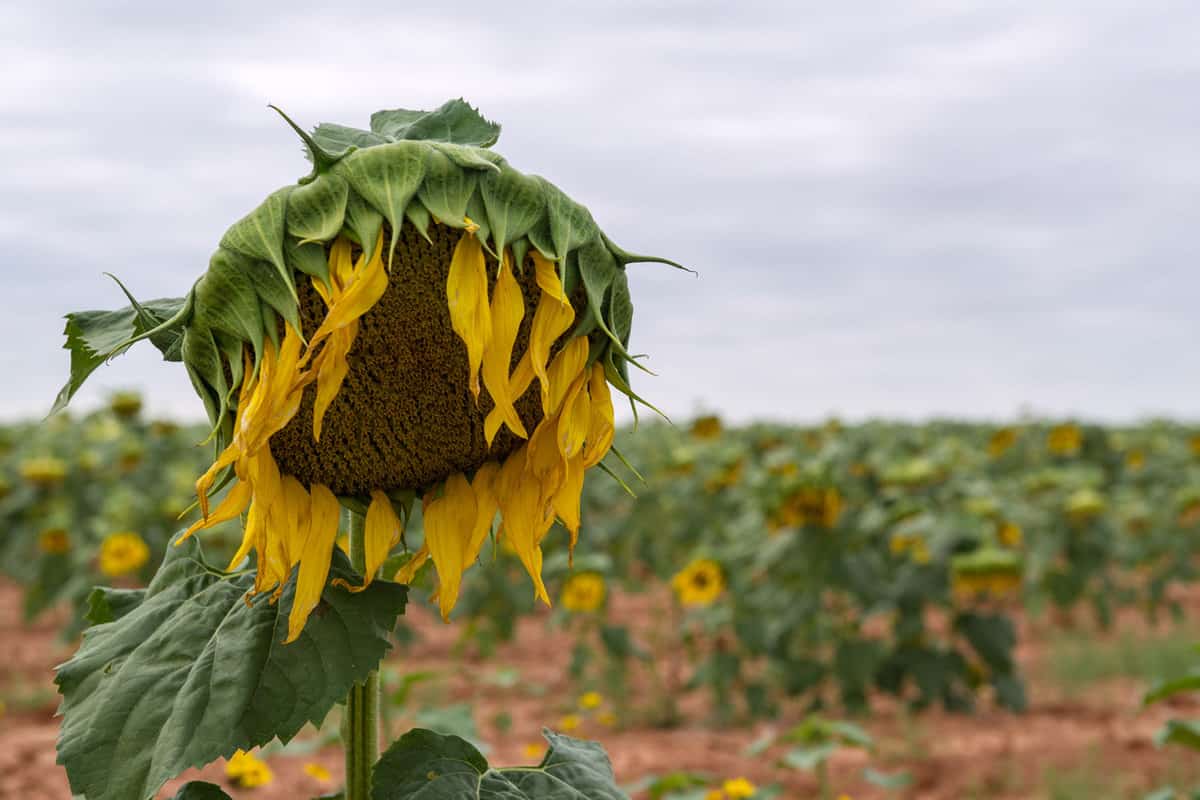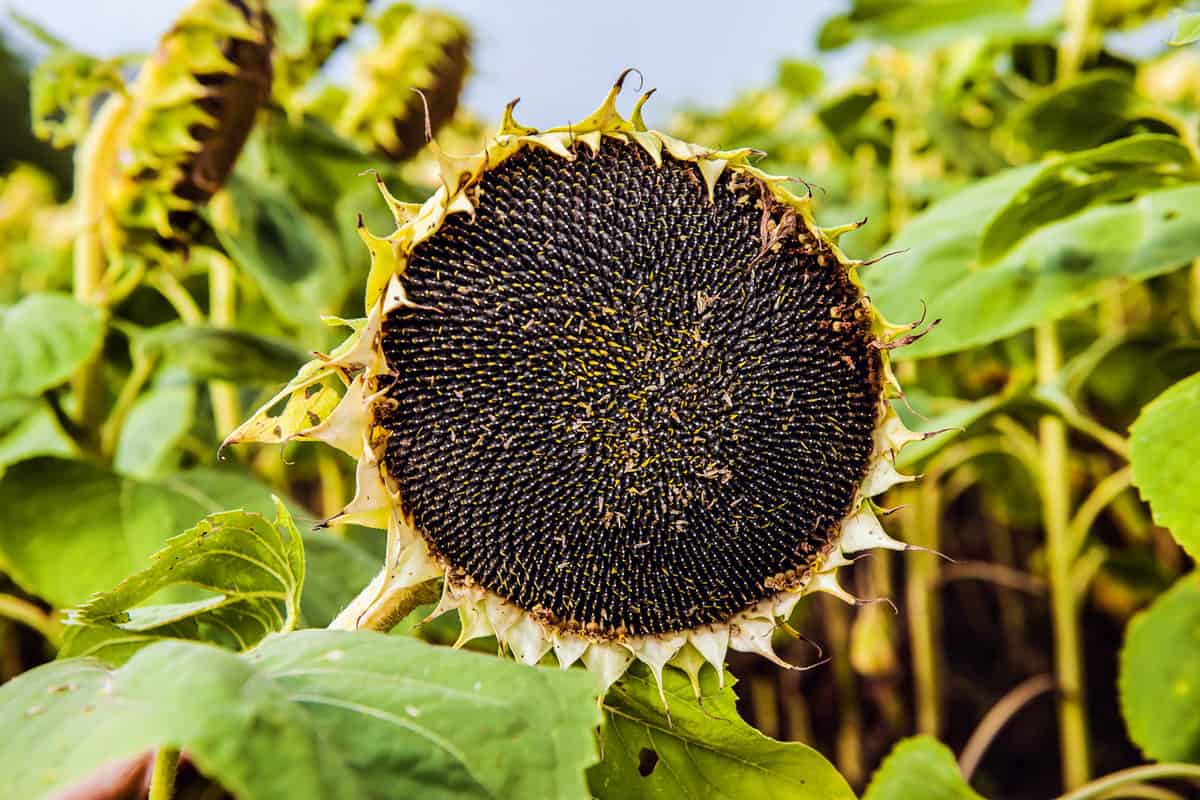Sunflowers are iconic flowers that brighten any garden with golden-yellow petals and a tall, striking appearance.
However, these otherwise robust and carefree plants sometimes begin to wilt, droop, and shrivel up, causing gardeners to wonder why their sunflowers are dying.
Sunflowers can quickly go from thriving to dying due to insufficient sunlight, poor drainage or improper pH in the soil, overwatering, lack of fertilization, or damage from pests.
When sunflowers start wilting and drooping, the underlying issue causing the problem must be fixed. We'll show you how to do just that.
Why are your sunflowers dying?
When your once-vibrant sunflowers are looking drab and lifeless, there are five key underlying issues likely at play.
1. Insufficient Sunlight
Sunflowers are sun worshippers, requiring full sun exposure for at least 6 to 8 hours per day.
Indoor sunflowers and those in shaded gardens can perish from lack of sunlight, diminishing their energy to grow and bloom.
2. Improper Soil Conditions
Sunflowers thrive in well-draining, sandy-loam soil with a balanced pH between 6.0-7.5.
Compacted, clayey soil or one that retains too much moisture can lead to root rot.
Unamended, acidic, or alkaline soil prohibits nutrient absorption, stunting growth.
3. Overwatering & Underwatering
While sunflowers need about 1 to 1.5 inches of water per week, drying soil between watering helps prevent fungal issues.
Excessive moisture can rot the stem and roots, while drought conditions can stress the plants.
4. Lack of Nutrients
Sunflowers are heavy feeders, craving essential nutrients like nitrogen, phosphorus, and potassium.
Fertilizers, compost, and balanced soil contribute to lush growth, while nutrient deficiencies lead to yellowing leaves and weak plants.
5. Pests & Diseases
Common pests such as aphids, snails, birds, and deer can damage foliage and flowers.
Fungal diseases like downy mildew and rust create spots, holes, and webbing, which should be addressed promptly with proper treatment to save the plant.
| Cause | Solution |
|---|---|
| Insufficient Sunlight | Ensure full sun exposure for at least 6 to 8 hours per day; avoid planting in shaded gardens or keeping indoors. |
| Improper Soil Conditions | Use well-draining, sandy-loam soil with a balanced pH between 6.0-7.5; avoid compacted, clayey soil. |
| Overwatering & Underwatering | Water 1 to 1.5 inches per week, allowing soil to dry between watering to prevent fungal issues. |
| Lack of Nutrients | Provide essential nutrients like nitrogen, phosphorus, and potassium through fertilizers and compost. |
| Pests & Diseases | Monitor for common pests and diseases, treating promptly with proper treatment to save the plant. |
Before throwing in the towel, keep reading to learn typical reasons why sunflowers may be dying and what you can do to keep your sunflowers happy, healthy, and lovely.
How Do You Know When a Sunflower is Dying?
A sunflower will signal that it is dying with stunted growth followed by dropped leaves, the leaves and stem turning yellow, brown, or black, and the petals on the flower head shriveling up.
Depending on how severe the symptoms are for the sunflower and the cause of its problems, you might be able to save the plant before it is too late.
What to do with a dead sunflower?
Sunflowers that die of natural causes can be safely placed in a compost bin and repurposed, but diseased sunflowers should be discarded.
How Long Do Sunflowers Last?
The bloom of a sunflower typically lasts for two to three weeks, depending on the variety and when you planted the flowers. Cut flowers may last two to three days or longer.
Annual vs. Perennial Sunflowers lifespan
The lifespan of a sunflower depends on whether it is an annual variety that dies off each year or a perennial that comes back.
Annual sunflowers will naturally die after flowering and setting seed, usually living for just one growing season.
Perennial sunflowers can continue living and blooming for several years. Both annual and perennial sunflowers may die eventually due to old age and the completion of their natural life cycle.
The death of an annual sunflower after flowering or a perennial after some years is normal.
Understanding the natural lifespan of sunflower varieties helps gauge whether their decline is expected or requires troubleshooting.
As a rule of thumb, smaller sunflowers are usually great for growing indoors and will last for years, but annual sunflowers will die after a year and not return.
Common Problems for Sunflowers
We've covered the five most common reasons why sunflowers are dying, but a few more things are worth discussing.
Not only is it vital to give sunflowers enough space to grow established root systems to reach the sky, but they also need plenty of nutrition, well-draining soil, adequate water, and routine maintenance.
Giving sunflowers proper TLC and an environment where they can thrive may be the difference between a beautiful garden worth envying versus worrying over wilting and dying flowers.
Lack of Nitrogen
I mentioned nutrients in general early on, but let's focus on one of the most common issues that typically lead to a sunflower plant dying: nitrogen deficiency.

To grow tall and healthy, sunflowers demand significant nitrogen in their soil. The amount of nitrogen in the soil will impact the size of a sunflower, the seed yield, and leaf development.
Because sunflowers are deep-rooted plants, it is advisable to administer fertilizer to keep them well-fed and happy. In addition to nitrogen, sunflowers need potash and potassium.
Balance is critical, as giving sunflowers too much nitrogen can lead to fewer flowers. Look into whether the variety of sunflower you are growing is perennial or annual, and start with a low-nitrogen fertilizer.
You will want to add fertilizer to the soil before planting to start your sunflowers well. If there is too little nitrogen or you forego fertilizing a sunflower, its leaves may begin to turn yellow and will drop off.
Most plants will display stunted growth and thinner stems when nitrogen in the soil is lacking.
Sunflower Roots Need Space
Unless you are growing a dwarf variety of sunflowers indoors in a pot, you will want to give outdoor sunflowers plenty of space in a garden bed so their roots can spread out and establish themselves.
Checking the soil, turning it over, and removing any obstacles before planting is critical.
If the root system of a sunflower encounters a problem and is blocked, it can lead to stunted growth, competition for nutrients and water, and lead health problems.
A potted sunflower that is planted with too many competing nearby plants may die if it can't get enough room, water, or food to thrive.
Extreme weather conditions
In climates with extreme winters, sunflowers may also perish from frost damage and cold temperatures if not properly protected and cared for over the winter months.
Get tips on how to safeguard your sunflowers from winter's wrath in our in-depth sunflower winter care guide.
Soil pH Testing for Healthy Sunflowers
- DIY Test Kits: These kits are available at garden centers and come with all the necessary tools and instructions for you to conduct the test at home. They're easy to use and provide quick results.
- Digital pH Meters: These portable devices provide instant and accurate soil pH readings. Insert the probe into the soil; the device will display the pH level.
- Soil Testing Laboratories: You can send a soil sample to a professional soil testing lab for a comprehensive analysis. They'll provide you with detailed information about your soil's pH and nutrient levels.
Adjusting Soil pH
If your soil pH is outside the ideal range for sunflowers, you can take steps to adjust it.
- You can add lime to the soil to raise soil pH (make it more alkaline).
- To lower soil pH (make it more acidic), you can incorporate sulfur or organic matter like compost and peat moss.
Remember to retest your soil after making adjustments to ensure it's within the desired range.
Check out this meter for the soil on Amazon.
Choosing the Right Fertilizer for Your Sunflowers
Understanding N-P-K Ratios
The key to picking the right fertilizer lies in the N-P-K ratio, which stands for nitrogen (N), phosphorus (P), and potassium (K).
This ratio represents the proportion of these three essential nutrients in the fertilizer.
For sunflowers, a balanced fertilizer with a ratio of 10-10-10 or 15-15-15 is generally recommended, ensuring the plants receive equal essential nutrients they need to grow tall and produce vibrant blooms.
Types of Fertilizers
These solid, slow-release fertilizers provide a steady supply of nutrients over time.
They are easy to apply and are a great choice for sunflowers as they support healthy growth and beautiful blooms.
Granular Fertilizers
These solid, slow-release fertilizers provide a steady supply of nutrients over time. They are easy to apply and are a great choice for sunflowers as they support healthy growth and beautiful blooms.
Liquid Fertilizers
These fertilizers are fast-acting and can be applied directly to the soil or sprayed onto the leaves. They are an excellent option for a quick boost of nutrients but need to be applied more frequently than granular fertilizers.
Organic Fertilizers
These natural fertilizers are derived from plant, animal, or mineral sources. They are a sustainable choice and provide a broad spectrum of nutrients to the soil, improving its overall health.
Sunflowers benefit from regular fertilization throughout their growing season.
Start with a balanced fertilizer when planting seeds or transplants. As the sunflowers grow, you can switch to a high-potassium fertilizer to support strong stems and vibrant blooms.
Remember to follow the recommended application rates and schedules on the fertilizer package to avoid over-fertilization, which can harm your plants.
When is the Best Time to Fertilize Sunflowers?
Sunflowers grown outdoors do well when you apply a slow-releasing granular fertilizer that reaches the root system deep in the soil.
Before planting a sunflower, you should fertilize the soil, apply fertilizer, and water it weekly as needed until it establishes itself.
When you are ready to usher sunflowers into a dormant state, you will want to cease adding fertilizer to the soil.
So, How Do You Revive a Dying Sunflower?

Indoor sunflowers that are struggling to hold on to life may need to be repotted so they have more space, given water if the soil has been left parched for too long, or be given fertilizer for a boost of nutrients.
Outdoor sunflowers and indoor sunflowers should be given adequate sunlight to thrive, in addition to practicing things like mulching, removing damaged leaves and pests on sight, and removing dead or damaged flower heads from the stem.
Also, make sure that your sunflower is protected in the winter if it is a perennial variety so it can return next year.
![Sunflower plant in the fall wilting - Why Are My Sunflowers Dying [And How to Save Them]](https://gardentabs.com/wp-content/uploads/2020/06/Sunflower-plant-in-the-fall-wilting-Why-Are-My-Sunflowers-Dying-And-How-to-Save-Them.png)
Check out this plant protector for wintertime on Amazon.
Need to save this article? Here are images you can use for your Pinterest board -
![Inside of a field of dried sunflowers, Why Are My Sunflowers Dying? [And how to save them]](https://gardentabs.com/wp-content/uploads/2020/06/Why-Are-My-Sunflowers-Dying-And-how-to-save-them.jpg)
![Why Are My Sunflowers Dying? [And How to Save Them]](https://gardentabs.com/wp-content/uploads/2023/05/Why-Are-My-Sunflowers-Dying-And-How-to-Save-Them.png)

